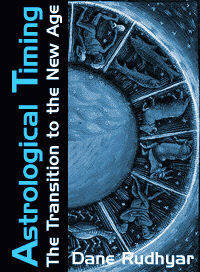 |
| Home | Bio | Art | Music | Literature | Civilization & Culture | Philosophy of Wholeness | Theosophy & Spirituality | Astrology |

ASTROLOGICAL TIMING
The Transition to the New Age by Dane Rudhyar, 1969 First published under the title Birth Patterns for a New Humanity
CONTENTS
PROLOGUE Where Do We Stand Today? PART ONE 1. Three Centuries of Crisis 2. Planetary Cycles 3. Cycles of Relationship PART TWO 4. Stars, Constellations and Signs of the Zodiac Page 1 Constellations vs. Signs Page 2 Page 3 The Nature of Astrology Page 4 Page 5 The Stars Are Not "Fixed" Page 6 Page 7 5. From Buddha to Christ 6. The Structure of the Piscean Age 7. At the Gates of the New Age 8. The Aquarius-Leo Age PART THREE 9. The Zodiacal Earth-Field 10. As We Face the Future EPILOGUE |

CHAPTER FOUR
Stars, Constellations and Signs of the Zodiac - 2 Constellations vs. Signs The stars which can be taken as indicators of this periodical displacement of the equinoxes are naturally those found near the ecliptic; and these stars — indeed all stars — have been grouped for millennia into "constellations". The names, sizes and boundaries of such constellations have differed in various civilizations; but some definite parallelisms can be established between variously defined constellations if one does not go too far in making the comparisons. Evidently, either the tendency to group stars into constellations to which, more often than not, the names of animals were given corresponds to a world-wide human desire. It may very well be a projection of the concept of animal "totems" — so basic in archaic tribal societies — upon the celestial sphere. Even in Greek mythology we see human heroes or personages of special significance glorified into constellations in the sky — somewhat as the Catholic Church canonizes its saints and gives them "feast days" in the ritual of the sacramental year. The sky, for ancient societies, was the great symbol of order and creative activity. Stars and planets were seen as the bodies of gods. The sky as a whole represented the "world of formation", the world of creative gods and hierarchies of divine minds; and the whole concept of celestial constellation has, I feel certain, a mythological origin. This does not take anything away from its meaning, for myths are extremely potent factors in the evolution and formation of human consciousness; and modern science itself contains a number of myths, which now are referred to as premises, postulates, or perhaps "universal constants", the constancy and universality of which — I repeat — is a matter of belief, even if the values to which these "constants" refer are based on proven facts — but facts in our present earth-environment, which does not mean always and anywhere. However this may be, the great problem concerning the twelve zodiacal constellations — groups of stars found on either side of the ecliptic — is the determination of their boundaries. Not only have these boundaries presumably been changed, time after time, but according to various occult traditions, their number has not been always twelve. H. P. Blavatsky claimed that originally there were only ten. Besides, several civilizations had "lunar zodiacs" divided into 27 or 28 "mansions" before they had "solar zodiacs". There is no real reason to believe that our zodiacal constellations should all be of equal size (i. e. covering each 30 degrees of longitude) and when the International Astronomical Union in 1928 sought to remedy the uncertainty of boundaries by defining these by celestial circles, parallel and perpendicular to the celestial equator, the result was quite puzzling. What we call a zodiacal sign in astrology is something entirely different in principle from a constellation of stars. A zodiacal sign is simply one-twelfth of the ecliptic — that is, a 30-degree section of the apparent yearly path of the sun (the earth's orbit in the modern heliocentric system). A zodiacal sign belongs to the tropical zodiac, while the twelve zodiacal constellations belong to the sidereal zodiac. Both unfortunately bear the same names. The tropical zodiac is measured in terms of degrees of longitude, and it begins at the point where the sun crosses the celestial equatorial plane in a northward direction at the spring (or vernal) equinox. At the spring equinox the sun has longitude 0°, and also declination 0° ("declination" measures the distance of any celestial body north or south of the celestial equator). This means that at the spring equinox the sun sets exactly at the west, that day and night are of equal length, and that the days are growing longer. At the fall equinox the sun has longitude 180° and also declination 0°, but then it is crossing the celestial equator in a southward direction. The days and nights are of equal length, but now the nights are growing longer. By permission of Leyla Rudhyar Hill Copyright © 1969 by Dane Rudhyar and Copyright © 2001 by Leyla Rudhyar Hill All Rights Reserved.  Web design and all data, text and graphics appearing on this site are protected by US and International Copyright and are not to be reproduced, distributed, circulated, offered for sale, or given away, in any form, by any means, electronic or conventional. See Notices for full copyright statement and conditions of use. Web design copyright © 2000-2004 by Michael R. Meyer. All Rights Reserved. |
 |